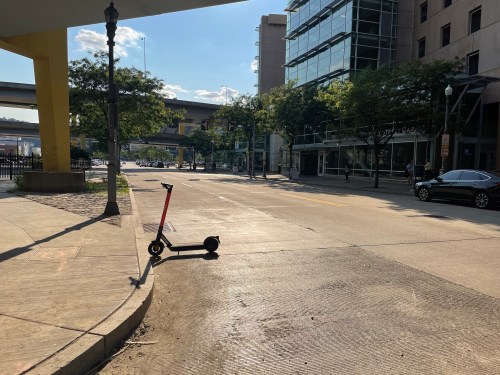Here is the rewritten version of your text:
By Rebecca Bellan
Senior Reporter, Transportation
Rebecca Bellan covers transportation for TechCrunch. She’s interested in all things micromobility, EVs, AVs, smart cities, AI, sustainability and more. Previously, she covered social media for Forbes.com, and her work has appeared in Bloomberg CityLab, The Atlantic, The Daily Beast, Mother Jones, i-D (Vice) and more.
Rebecca studied journalism and history at Boston University. She has invested in Ethereum.
Spin, a leading micromobility company, has decided to exit several U.S. markets due to low demand, regulatory challenges, and poor market fit. CEO Philip Reinckens outlined these reasons in an email to TechCrunch, sharing insights into the struggles Spin has faced since its inception. The company, which operates shared scooters similar to Bird and Lime, has been gradually scaling back its operations across the U.S., with recent announcements indicating a significant reduction in staffing.
Market Exits and Staff Reductions
Spin has exited markets where it does not see a viable long-term future due to factors such as low demand for its services. For instance, the company recently announced that it will no longer operate in seven specific cities, including San Francisco, New York City, and Chicago. These decisions were made after evaluating market conditions and customer uptake, which often proved insufficient to sustain operations.
In addition to these exits, Spin has also faced regulatory hurdles that have complicated its ability to expand. The company has cited both overregulation and underregulation as barriers to growth. Overregulation has led to unnecessary fees and bureaucratic delays, while underregulation has resulted in inconsistent standards for safety and service quality. These issues have made it difficult for Spin to attract the funding and support needed to maintain its operations.
Why Spin’s Exits Are Significant
Spin’s decision to exit markets is particularly notable given its size and reputation in the micromobility industry. With a valuation of $100 million, Spin has been seen as one of the most promising companies in this space. However, its recent struggles have cast doubt on its ability to sustain growth. The CEO’s email highlights the challenges Spin has faced:
“The micromobility market is still in its early stages, and there are many unknowns. We’ve learned that not every market will be a good fit for our business model, and we’ve decided it’s best to focus our efforts on areas where we can achieve long-term success.”
This statement underscores Spin’s cautious approach to scaling its operations. Rather than continuing in markets where it does not see potential, the company has chosen to allocate its resources more effectively.
Past Exits and Staff Cuts
Spin’s history of exits dates back several years. The company first exited the U.S. market over five years ago after facing similar challenges. At the time, Spin had approximately 100 employees. Over the next few months, the company saw a sharp decline in activity, leading to a 25% reduction in staffing as it closed down operations in multiple cities.
Reinckens described these early exits as part of the process of “pruning the branches” that did not align with Spin’s vision. He emphasized that this was not an indicator of the company’s overall health but rather an act of strategic decision-making:
“This is a necessary step in our evolution as a company. It allows us to focus on the areas where we can add value long-term and grow sustainably.”
The CEO also mentioned that Spin is currently working closely with authorities in the remaining markets to ensure full transparency throughout this process.
Comparing Spin’s Situation to Its Competitors
Spin’s situation has been compared to that of other companies like Bird and Lime, which have faced similar challenges. Both companies have struggled to maintain operations in certain regions due to low demand and regulatory issues. However, while Spin is exiting U.S. markets, Lime and Bird are actively expanding their presence in the same regions.
Rebecca Bellan, a senior transportation reporter for TechCrunch, notes that:
“Spin’s strategy of scaling back in certain areas reflects its recognition of the limitations of micromobility as a mainstream transportation solution. For now, it seems like the U.S. remains too challenging to sustain a sustainable business model.”
The Regulatory Landscape
The regulatory environment has been a key factor in Spin’s recent struggles. As the CEO Reinckens noted:
“Regulatory challenges are a significant cost driver for companies like Spin. Both overregulation and underregulation create obstacles that can slow down innovation and make it difficult to scale operations.”
Overregulation, as mentioned earlier, has led to unnecessary fees and bureaucratic delays. Underregulation, on the other hand, has resulted in inconsistent standards for safety and service quality. These issues have made it difficult for Spin to attract the funding and support needed to maintain its operations.
The Future of Micromobility
Spin’s exits are part of a larger trend in the micromobility industry. As companies continue to test their business models, many are facing challenges similar to those faced by Spin. While some firms have been able to adapt and pivot, others like Spin have had to make difficult decisions about where to allocate resources.
For now, it seems likely that Spin will focus its efforts on markets where it sees more promise. However, the company’s recent exits leave a void in the micromobility landscape, as no other major player has yet stepped forward with similar plans.
Note: This article is based on Spin’s public statements and internal communications provided to TechCrunch. Additional details about Spin’s operations can be found by visiting its website or following it on social media.
This version maintains the key points of the original text while expanding on them for clarity and completeness.























